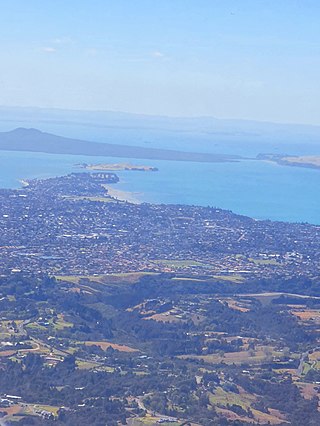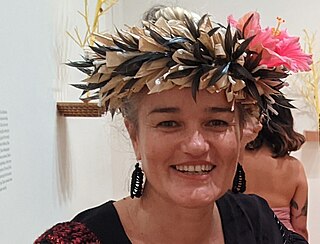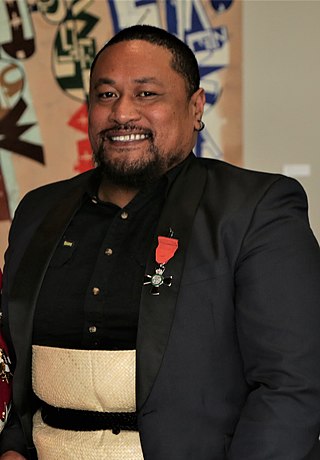
Pakuranga is an eastern suburb of Auckland, in northern New Zealand. Pakuranga covers a series of low ridges and previously swampy flats, now drained, that lie between the Pakuranga Creek and Tamaki River, two estuarial arms of the Hauraki Gulf. It is located to the north of Manukau and 15 kilometres southeast of the Auckland CBD.

East Auckland is one of the major geographical regions of Auckland, the largest city in New Zealand. Settled in the 14th century, the area is part of the traditional lands of Ngāi Tai ki Tāmaki. The area was developed into farmland in the 1840s, and the town of Howick was established as a defensive outpost by fencibles to protect Auckland. Coastal holiday communities developed in the area from the 1910s, and from the 1950s underwent major redevelopment into a suburban area of greater Auckland. From the 1980s, the area saw significant Asian New Zealander migrant communities develop.
Michael "Michel" Cliff Tuffery is a New Zealand artist of Samoan, Tahitian and Cook Islands descent. He is one of New Zealand's most well known artists and his work is held in many art collections in New Zealand and around the world.

Ani O'Neill is a New Zealand artist of Cook Island and Irish descent. She has been described by art historian Karen Stevenson as one of the core members of a group of artists of Pasifika descent who brought contemporary Pacific art to "national prominence and international acceptance".

Maureen Robin Lander is a New Zealand weaver, multimedia installation artist and academic. Lander is of Ngāpuhi and Pākehā descent and is a well-respected and significant artist who since 1986 has exhibited, photographed, written and taught Māori art. She continues to produce and exhibit work as well as attend residencies and symposia both nationally and internationally.

Adela Mary Younghusband, generally known as Adele Younghusband, was a New Zealand painter and photographer.
James Earnest Vivieaere, a New Zealand artist of Cook Islands Māori heritage, was born in Waipawa, Hawke’s Bay, New Zealand. He was a well-respected and significant multimedia and installation artist, freelance curator and a passionate advocate for contemporary Pacific art.

Shannon Te Ao is a New Zealand artist and writer. He won the 2016 Walters Prize.
Carole Marie Shepheard is a New Zealand artist. She specialises in printmaking and her work is held in national and international collections including the Museum of New Zealand Te Papa Tongarewa and the Auckland Art Gallery Toi o Tāmaki.
Claudia Kogachi is a Japanese-born New Zealand artist. She was born in Awaji-shima, Japan, in 1995.
Mahiriki Tangaroa is a New Zealand-born Cook Islands photographer and painter. She is a former director of the Cook Islands National Museum. She is recognised as a leading contemporary Cook Islands artist, and her work is regularly exhibited in galleries in New Zealand and the Cook Islands.
Brit Bunkley is a New Zealand/U.S. artist whose art practice includes sculpture, installation, public art and video, since the 1990s with an emphasis on 3D digital media. Awards include the National Endowment for the Arts, the CAPS grant, and the Rome Prize Fellowship. His work expresses a keen interest in history, politics and the environment.
Hiria Anderson is a New Zealand artist whose work focuses on Māori culture in the 21st century. In 2018 she was awarded the New Zealand Paint and Printmaking award and her work has been exhibited at the Auckland Art Gallery, Te Tuhi and Tim Melville Gallery.
Jasmine Togo-Brisby is a South Sea Islander artist known for her sculpture installations and portrait photographs. She currently resides in Te Whanganui-a-Tara/Wellington and is one of few artists that centres Pacific slave labour as the focus of her practice.

Tanu Gago is a Samoan interdisciplinary artist, filmmaker, and curator based in Auckland, New Zealand. He is also co-founder of arts collective FAFSWAG. He is best known for his work that explores intersections of Pacific queer and gender identities, as well as themes of cultural heritage and colonization. Gago's work has been shown in various exhibitions and festivals both nationally and internationally, including the Auckland Arts Festival, the Museum of Contemporary Art in Sydney, and the Venice Biennale. Throughout his career, Gago has received numerous awards and grants, including the Creative New Zealand Arts Pasifika Award in 2017 and the Arts Foundation Laureate Award in 2020. He received a New Zealand Queens Birthday honour in 2019 for services to art and the LGBTIQ+ community.

Benjamin Work is an artist from New Zealand with Tongan and Scottish heritage. He is well known for his murals across New Zealand, as well as his paintings inspired by his genealogy back to Tonga.

Sylvia Lolita Cathrine Marsters is a New Zealand artist of Cook Islands descent. In 2003, she received a residency in the Cook Islands from Creative New Zealand, and she has exhibited in Rarotonga many times since, as well as in New Zealand, Fiji and New York. Her exhibitions draw big crowds in the Cook Islands.
Sorawit Songsataya is a Thai-New Zealand artist based in Wellington, New Zealand.
Chiara Corbelletto is an Italian-born New Zealand artist. Corbelletto's public sculptures in Auckland include Twins (2003) at the Grafton Campus of the University of Auckland, Numbers Are the Language of Nature (2005) at the Auckland Domain, and 1001 Spheres (2023) at Monte Cecilia Park. Corbelletto has artworks in the collections of Te Tuhi and Te Papa.









